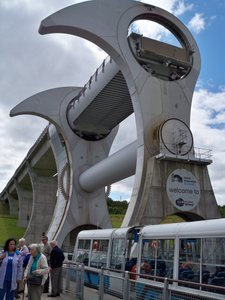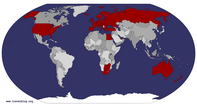Advertisement
Published: July 15th 2009

 The Falkirk Wheel
The Falkirk Wheel
An engineers paradiseWednesday 8th July
More Scottish castles and monuments and a unique piece of machinery
After a day of staying in the city yesterday we decided to take a road trip today and head for Stirling to take in the castle and William Wallace memorial with a stop at Falkirk on the way.
We had moved RR back to a parking space across the road from the flat that became free after 5.30pm yesterday but we still had to be alert by 8.30am this morning to put some money in the meter before the wardens started their round.And again as I went out just after 8.30am to do just that a warden was walking down the road towards me.They really are on the ball in this city!!
Leaving the driving to Gretchen, I was again to be the navigator and planned a route to Falkirk that would avoid the main highways.Also rather than try and find a quick way out of the city we would follow the road south that bought us into the city and then join the ring road the A720 which would at least mean we would avoid the traffic lights prevalent throughout the city streets.
We passed through
the towns of Newbridge,Broxburn and Linlithgow on our way west to Falkirk.The countryside was pleasant but with more animals in the fields than crops which we had seen when we had travelled north of the Forth on Monday.
The attraction we were heading for was the Falkirk Wheel which Leigh has said was a must see.We followed the brown tourist signs weaving through the city of Falkirk and past the new and very impressive soccer stadium and finally arrived at the Wheel park.
The Wheel only came into our view after we had parked the car and walked up a pathway.
And what a sight it was!!! This place is an engineers dream!!
The Wheel is a structure that was built for the Millenium and was part of the revitalisation of the old and disused canal system between Edinburgh and Glasgow with Falkirk in the middle.
It is difficult for non engineer types like ourselves to explain what the structure looks like so check the photos out with this blog and you will get the idea.
We do know now that the Wheel was designed to replace 11 locks that canal boats used to have to pass through to negotiate
a relatively small section of the canal at Falkirk.
Those involved in the reopening of the disused canal system fir leisure purposes commissioned engineers to come up with something radical to overcome the lock problem and this was the result.The Wheel is still the only one of its type in the world although information boards in the visitor centre did indicate its design was being considered elsewhere in the world where canals were now back in use.
We were fortunate to arrive just shortly before one of the hourly trips in a boat that would ride the Wheel up and take a short trip on the canal before turning around and returning to come back down on the wheel.
Before our trip began the Wheel cranked into action and we watched with fascination as it slowly turned and eventually as the cradle that had been at the top came fully into view revealing a canal boat riding to the lower lake and ready to continue its journey.
The drop from the canal at the top of the Wheel to the bottom is approx 30 mtrs and the whole rotation to bring the canal boat down took about 3 minutes.This would
have been a huge saving of time and effort over what would have been required when 11 locks would have had to be negotiated to travel the same distance.
Our boat,which we estimated held about 160 people,edged out in to the canal and moved forward into the cradle in preparation for the Wheel to lift us up the 30 mtrs to the upper canal.The Wheel can only start when the two cradles equate each other in weight so if the other cradle doesn’t carry a boat then it requires some more water to ensure stability.
The whole process operated very quietly and smoothly and the upward movement of our boat laden with people in its cradle was initially hard to detect until the scenery started to change for us and we were looking at farmland out in the distance rather than the visitor centre.
At the top the boat sailed out of its cradle and chugged through a small tunnel to a turning area where the next actual lock was located.We then sailed back to the Wheel for the downward trip going through the same process.
It was an amazing experience and one that we were very glad we did not not miss,so thanks for that one Leigh!!
After a tailgate lunch in the car park we headed for Stirling realising that the afternoon was pushing on.It isn’t that there isn’t enough daylight as it is still light until after 10pm but most of the attractions close at 5pm or 6pm and a late afternoon start doesn’t leave a lot of time to see all we want to while the attractions are still open.
We use our Historic Scotland cards for entrance to Stirling Castle and also signed up for a guided tour later of the Duke of Argylls house just down the road from the castle.
Like Edinburgh,the castle in Stirling commands the highest point in the small city atop a rocky small hill.As we found out later in the day at the William Wallace memorial,looking across to the castle, the outcrop on the floor of the valley looks out of place on a relatively flat landscape.
While we waited for a guided tour to start we took in the old bowling lawn in front of the palace and peered over the edge of the wall down a couple of hundred feet to what had been the royal gardens where crops were grown for the Royal family and their entourage and soldiers occupying the castle.
The guided tour was going to take about 50 minutes and then we would need to hurry off down the hill to the Duke’s house for that tour to complete the double.
The palace,which is the largest building in the castle environs was closed as it is being renovated so that shortened the tour that they would normally give.There were still enough b uildings and sights to see and the guide was full of history information for us to whet our appetite as we immersed ourselves in the long history of the castle dating back to around 1200.The Battle of Stirling Bridge in which William Wallace defeated the English in 1197 was centred around the Castle as was the second great victory by the Scots over the English by Robert the Bruce at Bannockburn in 1214 nearby.
The Great Hall of the castle was the most impressive building and is actually larger than the hall at Edinburgh Castle.
The army had occupied the castle for the years since the joining of Scotland with England and they only moved out about 20 or so years ago .At that time the castle was taken over by Historic Scotland and it was readied to be opened up to the public.During that preparation, a lot of history that had been covered up or changed by the army in their occupation,was rediscovered and internal walls built by the army for their operations were taken down returning the castle to as close to its original state as could be achieved.
In the chapel there was a display of 4 huge tapestries that had been made from original drawings of similar ones that hung in the palace.Each of the tapestries had taken over 18months to make and we were able to visit the building where the work is going on today.Our guide explained that the tapestries were like a book as the people of the day could not read or write in the main and each one told a story of the times.
The tour finished as predicted within 50 minutes and we raced off down the hill only to find the tour of the Duke of Argylls house had already started and we had got the time wrong by 15 minutes.
So we went back up the hill to the castle and finished off a couple of other places the guided tour had not gone including the castles kitchens which had been buried in the 1600’s when it was thought that the land above the kitchens might collapse if the cannons all fired at once above them.Their location had been forgotten about until someone doing some work on the site in the 1920’s rediscovered them again and they were excavated.
The William Wallace had been visible from almost everywhere we went at Stirling Castle and so with the castle behind us we drove the short distance to take in the memorial,also on a hill.Arriving at 5.30pm we were too late to buy a ticket to climb the tower but the access to the grounds and the hill the tower stood on was free and still open.The pathway up was steep but the view from the top and base of the tower was worth the effort.
The view was about 270deg,west towards the highlands and Loch Lomond and southeast to the castle and the Bannockburn battlefield a little further away as well as over the city of Stirling.
After the demanding walk up the hill we quickly took the offer of the courtesay shuttle ride back down to the car park.Why hadn’t we been around when the shuttle went up the hill??!!
The route home to Edinburgh was via the M9 and the ring road to take us to the side of the city our home is.We arrived home just in time for our Wed session with Coro St.To all Coro St followers in NZ,our lips are sealed!!
Advertisement
Tot: 0.088s; Tpl: 0.012s; cc: 12; qc: 30; dbt: 0.0577s; 1; m:domysql w:travelblog (10.17.0.13); sld: 1;
; mem: 1.1mb













Rin
non-member comment
It's funny to see a photo of Stirling Castle with green grass in front of it, as we were there over Christmas and the whole of Stirling was covered in snow - together with the steep streets around the castle being coated in ice! And I know what you mean about that hill up to the William Wallace Memorial...I climbed that not long after getting over one of my cracker English colds and had the breathing capacity of a 98-year old at the time!